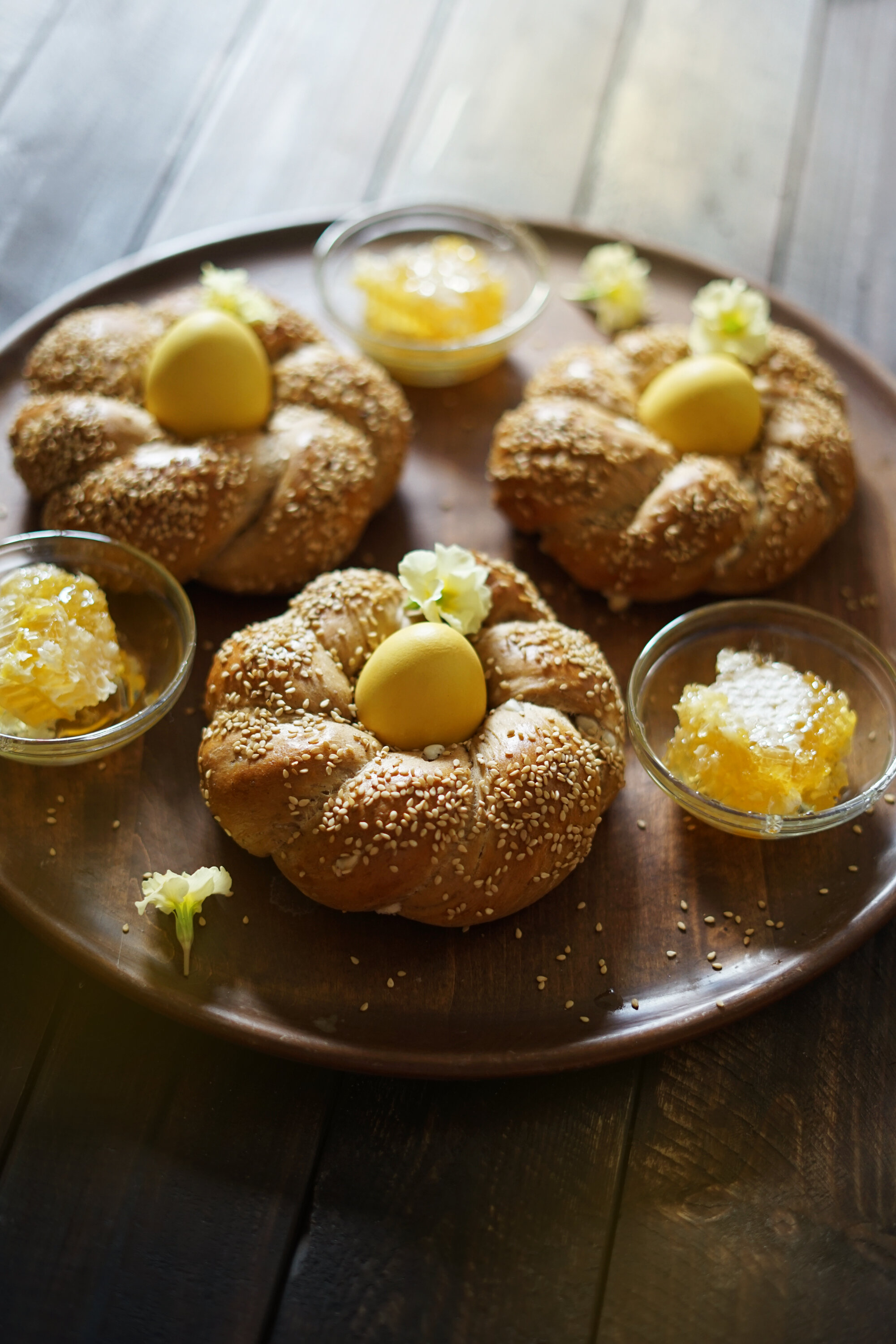Acorn Bread and Golden Eggs: A Ritual For Community
New to foraging? Learn more about ethical and safe foraging (plus how to get started) here!
One of the most visceral ways we relate to our histories - and our humanity - is through food. Take, for example, the Seder Plate shared on Passover in many Jewish households. This plate has simple, small servings of food, but these foods are presented and then partially consumed in a very specific, ritualized way to tell the history of their people. This annual experience reminds those at the table who they are, what they stand for, and what they as a community have endured.
Not coming from a Jewish background myself, I am always fascinated to hear about the layers of symbolism and storytelling that are practiced by one of my friends and her family. In just six tiny plates of different food is a saga of sacrifice, slavery, bitterness, loss, toiling, mourning, and the strength of God. This ritual reminds Jewish people of their history as slaves and the intolerance they have faced for many years. It reminds them to honor their heritage while also giving thanks for their freedom now. It keeps them connected to their ancestors.
And while the Seder Plate has remained a constant for hundreds of years, it is not immune to change. Certain new symbols are finding their way into this ritual, such as an orange to symbolize the intolerance of women and homosexuals in Judaism. It’s a strong symbol of inclusivity today and many families now include it along with the more traditional offerings.
If you were to describe your own story through edible symbolism, what would you put on your plate? How would you represent the griefs? The triumphs? What story would you tell that affirms who you are down to your core? These questions are just food for thought, but I can tell you honestly that bread (representing nurturing others) would be a big part of mine.
Food is indeed a powerful way for us to connect with our histories and our community. Below, you’ll find a simple family ritual to celebrate humility and humanity. It’s perfect for a group of tightly-knit friends or a family to do together to give gratitude and care a little boost into springtime. And yes, it includes bread.
I based these beautiful egg-studded loaves on traditional Italian and Greek Easter Bread recipes, though I’ve added a little Pacific Northwest heartiness in the form of acorn flour. The eggs baked into this bread were traditionally deep red in remembrance of Christ’s blood, but I’ve dyed mine a cheerful yellow instead as a celebration of our entrance into the light half of the year. It’s also no accident that this bread is full of fertility symbols: eggs, bread, honey, and seeds are all associated with springtime’s virility. These symbols of fertility are so widespread and ancient as to have become almost archetypes, associations that are important in finding your own metaphorical fertility in this season of blooming.
Community Ritual
You’ll need:
Acorn bread nests with eggs
Fresh honey
Small bowl of salt
Clean towels for everyone
Warm water infused with mugwort
Directions:
Gather your guests together around the table. Explain that you’ll be doing a short ritual before the main meal as a way to connect more deeply. Ask each guest to please rinse their hands in the fragrant water, then dry them on the provided towel.
Explain that the egg is a symbol of hope and fertility, and often associated with motherhood. Ask your guests to peel their egg while considering who has shown them nurturing in the past year. Acknowledge that it’s okay to accept help when you need it, and that nobody should ever have to face challenges completely alone. Feel the gratitude for those who were able to and chose to help you. Recognize that it was their choice and release any shame you might have about feeling “needy” or “burdensome.”
You may choose to keep these thoughts to yourself, or ask that they be shared aloud.
Now, you may eat your egg by dipping it in the sea salt blend.
Once everyone has finished eating their egg, tell them that the next step is about giving rather than receiving, two sides of one very important coin. Explain that healthy families and communities rely on each other and that life’s balance of ebb and flow is a natural way to interact with others.
Instruct your guests to break off a small part of their bread, dip it in honey, and gently and carefully feed it to the person on their left. This action will go around the circle until it reaches the beginning. Feeding another person is an act of great tenderness and accepting food from others shows trust and vulnerability. You may be surprised at some of the emotions this action can elicit.
Once again, have everyone rinse their hands and then dry them.
Wrap up the ritual by thanking everyone for their participation and acknowledging that they have re-strengthened their bonds together as a small community for the coming year.
Lastly, ask each person to think of one way to help someone they know with something, even minorly. Shoveling someone else’s walkway. Dropping off some pre-made meals during a time of stress. Writing an encouraging note to slip under a doorway. Remember that we all benefit both from the giving and from the receiving, if we allow ourselves to.
Acorn Bread Nests
Ingredients:
9 large eggs
1 tsp. White vinegar
1 tsp. salt
2 tsp. Turmeric
1 ¼ c. warm milk (about body temperature)
Pinch of sugar
2 ½ tsp. Active dry yeast
½ c. unsalted butter, softened
1/4 c. dark brown sugar
¼ c. honey
½ tsp. Salt
½ c. acorn flour (or chestnut or whole wheat)
4 - 4 1/2 c. all-purpose flour
½ c. white chocolate chips
1 tsp. orange zest
Sesame seeds
Directions:
First, dye 6 of your eggs. You’ll want to keep them raw as they’ll be baked along with the bread. I decided to make mine a cheerful yellow color. In a small saucepan, bring about 5 cups of water to a boil. Add the vinegar, salt, and turmeric and stir until everything is dissolved. Remove from heat and let cool to room temperature.
Meanwhile, let your fresh eggs soak in a solution of 5 c. water and 1 tsp. Vinegar for about an hour, gently stirring or moving them from time-to-time. (This slightly etches their shells so they pick up color better.) Then rinse and allow to dry.
Once the turmeric dye has cooled completely, dip your cleaned eggs into the solution. It’ll dry a little lighter than it looks, so decide how many dips you’d like. You can also keep the eggs in the dye overnight (move it to the fridge.) for a darker color. Just be sure to move them around a bit to avoid flat white spots.
To make the bread: stir the pinch of sugar into the warmed milk and sprinkle the yeast over the top. Let sit for 5 minutes, until the mixture is bubbly.
In a separate bowl, beat two of the eggs lightly.
In the bowl of a stand mixer fitted with a bread hook, add the milk mixture, butter, beaten eggs, brown sugar, salt, and 3 c. of flour. Use a spoon to stir until everything is just combined.
Beat the mixture on medium speed until smooth. Then add the acorn flour and the final 1 to 1 ½ c. flour to create a dough that is soft but cohesive. (It should still be slightly sticky). Beat for another 4-5 minutes using the dough hook on the mixer. Add the white chocolate chips and lemon zest and knead until they’re evenly distributed.
Place the dough into a lightly-greased bowl and top with plastic wrap. Allow to rest until doubled in size, about 1 hour.
Dump the risen dough onto a clean counter lightly dusted with flour. Line a large rimmed baking sheet with parchment paper or a silicone baking mat.
Divide the dough into 6 equal pieces. Keep the others covered while you work with each one.
Divide the blob of dough into 2 equal blobs. Roll each piece out to be 14” long. Attach the two ropes at their ends, then twist together to form a rope-like design. Pull the ends together to form a wreath and gently transfer to the baking sheet. Place one of the dyed eggs into the center of the wreath.
Repeat with the remaining 5 dough blobs, creating 6 little bread nests total. Cover lightly with plastic wrap and allow to rise for another 30 minutes. Meanwhile, preheat the oven to 350F.
Beat the final egg with a little water to create an egg wash. Gently brush the bread with the egg wash, being careful to avoid getting any on the egg in the middle. Sprinkle with sesame seeds.
Bake for 20-25 minutes, until golden brown. (A thermometer inserted in the middle should read 190F.) Remove from the oven and allow to cool before serving.
Love what you’ve read here? Don’t forget to Subscribe to get frequent updates of new posts!
Huge thanks to my Patrons that make sharing all of these lovely posts with you possible (without all of the pop-ups and ads that make browsing other blogs so annoying). If you’re feeling generous, you too can support the wonder with a monthly contribution of your choice. Even $1 helps a lot! Your donation will help to fund this blog as well as my surprise free events and gifts for strangers. Learn more about this program at the link below:





















Join me for a little winter night magic as we bake this cake full of rich seasonal flavors and black cocoa!